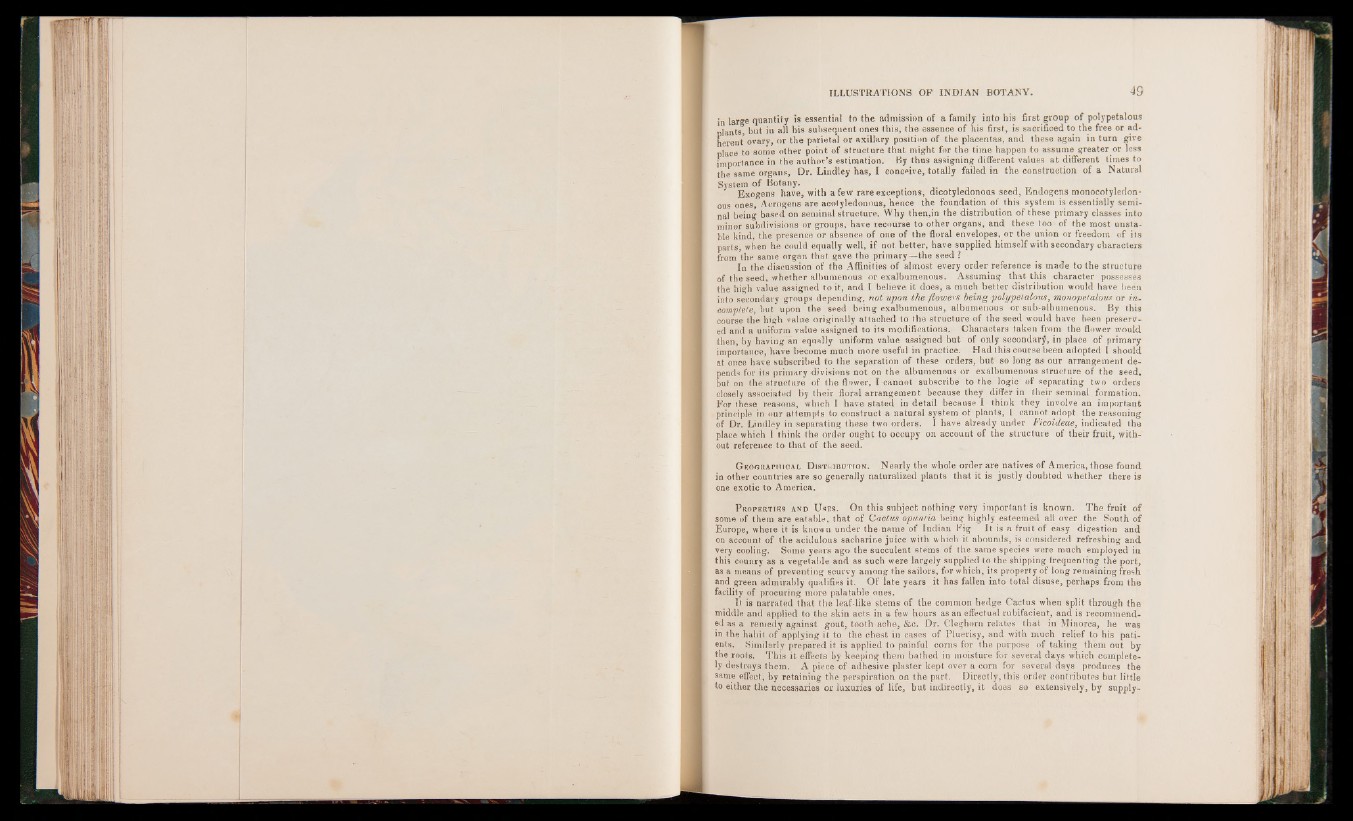
in large quantity is essential to the admission of a family into his first group of polypetalous
nlants but in all his subsequent ones this, the essence of his first, is sacrificed to the free or adherent
ovary, or the parietal or axillary position of the placentas, and these again in turn give
place to some other point of structure that might for the time happen to assume greater or less
in the author’s estimation. By thus assigning different values at different times to
Dr. Lindley has, I conceive, totally failed in the construction the same organs of a Natural
System of Botany.
Exogens have, with a few rare exceptions, dicotyledonous seed, Endogens monocotyledon-
ous ones, Acrogens are acotyledonous, hence the foundation of this system is essentially seminal
being based on seminal structure. Why then,in the distribution of these primary classes into
minor subdivisions or groups, have recourse to other organs, and these too of the most unstable
kind, the presence or absence of one of the floral envelopes, or the union or freedom of its
parts, when he could equally well, if not better, have supplied himself with secondary characters
from the same organ that gave the primary—the seed ?
In the discussion of the Affinities of almost every order reference is made to the structure
of the seed, whether albumenous or exalbumenous. Assuming that this character possesses
the high value assigned to it, and I believe it does, a much better distribution would have been
into secondary groups depending, not upon the flowers being polypetalous, monopetaloux or incomplete,
but upon the seed being exalbumenous, albumenous or sub-albumenous. By this
course the high value originally attached to the structure of the seed would have been preserved
and a uniform value assigned to its modifications. Characters taken from the flower would
then, by having an equally uniform value assigned but of only secondary, in place of primary
importance, have become much more useful in practice. Had this course been adopted I should
at once have subscribed to the separation of these orders, but so long as our arrangement depends
for its primary divisions not on the albumenous or exalbumenous structure of the seed,
but on the structure of the flower, I cannot subscribe to the logic of separating two orders
closely associated by their floral arrangement because they differ in their seminal formation.
For these reasons, which I have stated in detail because I think they involve an important
principle in our attempts to construct a natural system of plants, I cannot adopt the reasoning
of Dr. Lindley in separating these two orders. I have already under Ficoideae, indicated the
place which I think the order ought to occupy on account of the structure of their fruit, without
reference to that of the seed.
G eographical D istribution. Nearly the whole order are natives of America, those found
in other countries are so generally naturalized plants that it is justly doubted whether there is
one exotic to America.
P roperties and U ses. On this subject nothing very important is known. The fruit of
some of them are eatable, that of Cactus opuntia being highly esteemed all over the South of
Europe, where it is known under the name of Indian Fig It is a fruit of easy digestion and
on account of the acidulous sacharir.e juice with which it abounds, is considered refreshing and
very cooling. Some years ago the succulent stems of the same species were much employed in
this counry as a vegetable and as such were largely supplied to the shipping frequenting the port,
as a means of preventing scurvy among the sailors, for which, its property of long remaining fresh
and green admirably qualifies it. Of late years it has fallen into total disuse, perhaps from the
facility of procuring more palatable ones.
It is narrated that the leaf-like stems of the common hedge Cactus when split through the
middle and applied to the skin acts in a few hours as an effectual rubifacient, and is recommended
as a remedy against gout, tooth ache, &c. Dr. Cleghorn relates that in Minorca, he was
in the habit of applying it to the chest in cases of Pluerisy, and with much relief to his patients.
Similarly prepared it is applied to painful corns for the purpose of taking them out by
the roots. This it effects by keeping them bathed in moisture for several days which completely
destroys them. A piece of adhesive plaster kept over a corn for several days produces the
same effect, by retaining the perspiration on the part. Directly, this order contributes but little
to either the necessaries or luxuries of life, but indirectly, it does so extensively, by supply